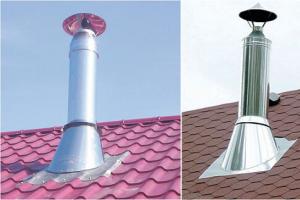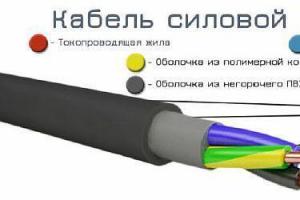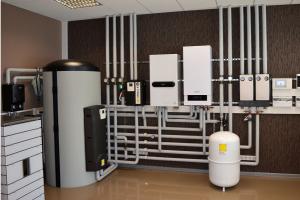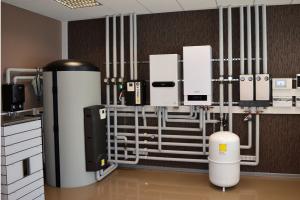When arranging a heating system and choosing an energy source, it is important to find out the future gas consumption for heating a house of 150 m2 or other area. Indeed, in recent years, a clear trend towards an increase in prices for natural gas has been established; the last increase in price by approximately 8.5% occurred recently, on July 1, 2016. This led to a direct increase in heating costs in apartments and cottages with individual heat sources using blue fuel. That is why developers and homeowners who are just choosing a gas boiler should calculate heating costs in advance.
Initial data for calculations
To perform a preliminary calculation, you need to find out the following parameters:
- calorific value (calorific value) of natural gas supplied in your area;
- Efficiency of the boiler that is planned to be installed in a house or apartment.
The calorific value of the fuel is taken based on the value of the lower calorific value of the main gas.
Theoretically, when burning 1 m³ of blue fuel, 9.2 kW of thermal energy is released. In practice, this value differs and, as a rule, to a lesser extent. Due to the same rise in price, some unscrupulous suppliers dilute gas with air, which is why its calorific value can decrease to 7.5-8 kW/m³.
To determine gas consumption for heating a house, it is better to find out the caloric value from the management company, and when this fails, use a reserve figure: 8 kW/m³. If they share with you information about the specific heat of combustion and give you a figure expressed in other units, kcal/h, then you can convert it to Watts by multiplying by a factor of 1.163.

Another important indicator that directly affects fuel consumption is the thermal load on the heating system, which consists of heat losses through the building structures and losses due to heating of ventilation air. The best option is to perform or order an accurate calculation of all heat losses, but in the absence of any other option, you can determine the load using enlarged methods:
- If the ceiling height does not exceed 3 m, then the heat consumption is assumed to be 0.1 kW per 1 m² of heated area of the building. Thus, for a house of 100 m2 you need about 10 kW of heat, 150 m2 - 15 kW and 200 m2 - 20 kW of heat energy.
- Apply 40-45 W of heat per 1 m³ of heated room volume. The load is determined by multiplying this value by the volume of all heated rooms.
The efficiency of the heat generator, which affects the efficiency of fuel combustion, is indicated in its technical data sheet. If the unit has not yet been purchased, then you can take the efficiency of gas boilers of various types from the list:
- gas convectors - 86%;
- boilers with an open combustion chamber - 88%;
- heat generators with a closed chamber - 92%;
- condensing boilers - 96%.

Performing Calculations
A preliminary calculation of gas consumption for heating is made using the formula:
V = Q / (q x efficiency / 100).
- q is the caloric content of fuel, the default is 8 kW/m³;
- V is the required main gas flow rate, m³/h;
- Efficiency is the efficiency of fuel combustion by a heat source, expressed in %;
- Q is the heating load of a private house, kW.
As an example, we offer the calculation of gas consumption in a small cottage with an area of 150 m² with a heating load of 15 kW. It is planned that the heating task will be performed by a heating unit with a closed combustion chamber (efficiency 92%). The theoretical fuel consumption per 1 hour in the coldest period will be:
During the day, the heat generator will consume 2.04 x 24 = 48.96 m³ (rounded - 49 cubic meters) of natural gas - this is the maximum consumption on the coldest days. But during the heating season, the temperature can fluctuate between 30-40°C (depending on the region of residence), so the average daily gas consumption will be half as much, about 25 cubic meters.
Then, on average, per month a turbocharged boiler uses 25 x 30 = 750 m³ of fuel to heat a house with an area of 150 m², located in central Russia. Consumption for cottages of other sizes is calculated in the same way. Based on preliminary calculations, it is possible to carry out measures aimed at reducing consumption even at the construction stage: insulation, selection of more efficient equipment and the use of automatic control devices.
Autonomous heating of private houses with liquefied propane or its mixture with butane has not yet lost its relevance in the Russian Federation, although in recent years it has noticeably increased in price. It is all the more important to calculate the future consumption of this type of fuel for those homeowners who are planning such heating. The same formula is used for the calculation, only instead of the lower calorific value of natural gas, the parameter value for propane is set: 12.5 kW with 1 kg of fuel. The efficiency of heat generators when burning propane remains unchanged.

Below is an example of a calculation for the same building of 150 m², only heated with liquefied fuel. Its consumption will be:
- for 1 hour - 15 / (12.5 x 92 / 100) = 1.3 kg, per day - 31.2 kg;
- on average per day - 31.2 / 2 = 15.6 kg;
- on average per month - 15.6 x 30 = 468 kg.
When calculating the consumption of liquefied gas for heating a house, it is necessary to take into account that fuel is usually sold in volumetric measures: liters and cubic meters, and not by weight. This is how propane is measured when filling cylinders or a gas tank. This means that it is necessary to convert mass into volume, knowing that 1 liter of liquefied gas weighs about 0.53 kg. The result for the example above will be:
468 / 0.53 = 883 liters, or 0.88 m³, propane will have to be burned on average per month for a building with an area of 150 m².
Considering that the retail cost of liquefied gas is on average 16 rubles. for 1 liter, heating will cost a considerable amount, about 14 thousand rubles. per month for the same cottage on one and a half hundred square meters. There is reason to think about how best to insulate walls and take other measures aimed at reducing gas consumption.
Many homeowners expect to use fuel not only for heating, but also to provide hot water supply. These are additional costs, they must be calculated, plus it is important to take into account the additional load on the heating equipment.
The thermal power required for hot water supply is easy to calculate. You need to determine the required volume of water per day and use the formula:
Q DHW = cm (t 2 - t 1).
- c is the heat capacity of water, equal to 4.187 kJ/kg °C;
- t 1 — initial water temperature, °C;
- t 2 — final temperature of heated water, °C;
- m is the amount of water consumed, kg.
As a rule, economical heating occurs to a temperature of 55 °C, and this must be substituted into the formula. The initial temperature varies and lies in the range of 4-10 °C. For a day, a family of 4 people requires approximately 80-100 liters for all needs, provided that it is used sparingly. It is not necessary to convert the volume into mass measures, since in the case of water they are almost the same (1 kg = 1 l). It remains to substitute the obtained value of Q DHW into the above formula and determine the additional gas consumption for DHW.
Based on the combination of convenience and cost-effectiveness criteria, probably no other system can compare with one running on natural gas. This determines the wide popularity of such a scheme - whenever possible, the owners of country houses choose it. And recently, owners of city apartments are increasingly striving to achieve complete autonomy in this matter by installing gas boilers. Yes, there will be significant initial costs and organizational hassle, but in return, homeowners get the opportunity to create the required level of comfort in their properties, and with minimal operating costs.

However, verbal assurances about the efficiency of gas heating equipment are not enough for a zealous owner - he still wants to know what energy consumption he should be prepared for, so that, based on local tariffs, he can express the costs in monetary terms. This is the subject of this publication, which was initially planned to be called “gas consumption for heating a house - formulas and examples of calculations for a room of 100 m².” But still, the author considered this not entirely fair. Firstly, why only 100 square meters. And secondly, consumption will depend not only on the area, and one might even say that not so much on it, as on a number of factors predetermined by the specifics of each particular house.
Therefore, we will rather talk about the calculation method, which should be suitable for any residential building or apartment. The calculations look quite cumbersome, but don’t worry - we have done everything possible to make them easy for any homeowner, even if they have never done this before.
General principles for calculating heating power and energy consumption
Why are such calculations carried out at all?
The use of gas as an energy carrier for the operation of the heating system is advantageous from all sides. First of all, they are attracted by the quite affordable tariffs for “blue fuel” - they cannot be compared with the seemingly more convenient and safe electric one. In terms of cost, only available types of solid fuel can compete, for example, if there are no special problems with the procurement or purchase of firewood. But in terms of operating costs - the need for regular delivery, organizing proper storage and constant monitoring of boiler loading, solid fuel heating equipment is completely inferior to gas heating equipment connected to the network supply.
In a word, if it is possible to choose this particular method of heating your home, then there is hardly any doubt about the feasibility of the installation.

It is clear that when choosing a boiler, one of the key criteria is always its thermal power, that is, the ability to generate a certain amount of thermal energy. To put it simply, the purchased equipment, according to its technical parameters, must ensure the maintenance of comfortable living conditions in any, even the most unfavorable conditions. This indicator is most often indicated in kilowatts, and, of course, is reflected in the cost of the boiler, its dimensions, and gas consumption. This means that the task when choosing is to purchase a model that fully meets the needs, but, at the same time, does not have unreasonably inflated characteristics - this is both disadvantageous for the owners and not very useful for the equipment itself.

It is important to understand one more point correctly. This is that the specified nameplate power of a gas boiler always shows its maximum energy potential. With the right approach, it should, of course, slightly exceed the calculated data for the required heat input for a particular house. In this way, the same operational reserve is laid down, which may someday be needed under the most unfavorable conditions, for example, during extreme cold, unusual for the area of residence. For example, if calculations show that for a country house the need for thermal energy is, say, 9.2 kW, then it would be wiser to opt for a model with a thermal power of 11.6 kW.
Will this capacity be fully utilized? – it’s quite possible that not. But its supply does not look excessive.
Why is all this explained in such detail? But only so that the reader becomes clear on one important point. It would be completely wrong to calculate the gas consumption of a specific heating system based solely on the equipment’s nameplate characteristics. Yes, as a rule, the technical documentation accompanying the heating unit indicates the energy consumption per unit of time (m³/hour), but this is again a largely theoretical value. And if you try to get the desired consumption forecast by simply multiplying this passport parameter by the number of hours (and then days, weeks, months) of operation, then you can come to such indicators that it will become scary!..

Often, passports indicate a consumption range - the boundaries of minimum and maximum consumption are indicated. But this probably will not be of great help in calculating real needs.
But it is still very useful to know gas consumption as close to reality as possible. This will help, firstly, in planning the family budget. Well, secondly, the possession of such information should, willingly or unwillingly, stimulate zealous owners to search for reserves of energy savings - perhaps it is worth taking certain steps to reduce consumption to the possible minimum.
Determining the required thermal power for efficient heating of a house or apartment
So, the starting point for determining gas consumption for heating needs should still be the thermal power that is required for these purposes. Let's start our calculations with it.
If you look through the mass of publications on this topic posted on the Internet, you will most often find recommendations to calculate the required power based on the area of the heated premises. Moreover, for this a constant is given: 100 watts per 1 square meter of area (or 1 kW per 10 m²).
Comfortable? - undoubtedly! Without any calculations, without even using a piece of paper and a pencil, you perform simple arithmetic operations in your head, for example, for a house with an area of 100 “squares” you need at least a 10-watt boiler.
Well, what about the accuracy of such calculations? Alas, in this matter everything is not so good...

Judge for yourself.
For example, will the thermal energy requirements of premises of the same area, say, in the Krasnodar Territory or regions of the Server Urals be equivalent? Is there a difference between a room bordering on heated premises, that is, having only one external wall, and a corner one, and also facing the windward north side? Will a differentiated approach be required for rooms with one window or those with panoramic glazing? You can list a few more similar, quite obvious, by the way, points - in principle, we will deal with this practically when we move on to the calculations.
So, there is no doubt that the required amount of thermal energy for heating a room is influenced not only by its area - it is necessary to take into account a number of factors related to the characteristics of the region and the specific location of the building, and the specifics of a particular room. It is clear that rooms within even the same house can have significant differences. Thus, the most correct approach would be to calculate the need for thermal power for each room where heating devices will be installed, and then, summing them up, find the total figure for the house (apartment).

The proposed calculation algorithm does not claim to be a professional calculation, but has a sufficient degree of accuracy, proven by practice. To make the task extremely simple for our readers, we suggest using the online calculator below, the program of which has already included all the necessary dependencies and correction factors. For greater clarity, brief instructions on how to perform the calculations will be provided in the text block below the calculator.
Calculator for calculating the required thermal power for heating (for a specific room)
When designing a gas heating system, all factors affecting gas consumption are taken into account: the size of the housing, the number of floors, insulation of the main structures, power and how many people live in the house. Heating a private home with gas is beneficial from an economic point of view for several reasons.
Benefits of use
Firstly, it is characterized by high efficiency of the combustion process due to its low sulfur content. This also allows you to save resources for cleaning the boiler. Secondly, it is easy to reduce heat losses and gas consumption with the help of good thermal insulation. Thirdly, gas is also an environmentally friendly material, since when it is burned, a very small amount of harmful substances is released into the atmosphere.
When using gas as a fuel for heating, the boiler walls do not suffer from corrosion, which increases the service life of the equipment. It is convenient to use liquefied gas: it has better quality and is delivered in cylinders to places where there are no highways, making life easier for thousands of people.
Complexity and cost features
Gas consumption for heating a house is directly proportional to the living area of the room. You can calculate the consumption in kW/hours by multiplying the boiler power by the number of hours/day and day/month. 
However, this mode is practically not used for everyday life. The real indicator for calculating gas consumption is the average monthly kW/hour. To do this, the maximum monthly consumption for heating a house is divided in half. If this is a residential building, then the calculation is made based on the length of the heating season.
Algorithm
Data for calculating boiler power are based on the ratio of 1 kW/h per room of 10 m². Thus, to heat a house with an area of 100 m², you will need to divide it by 10: i.e. the required power will be 10 kW/h.
How much gas is consumed for a different size house is calculated according to the same principle, i.e. the area is divided by 10. For example, for an area of 200 m2, the calculation will look like this: 200 m2/10, i.e. 20 kW/hour will be spent on heating this room.

Adjustment for days
Monthly gas consumption is calculated by multiplying the daily requirement of a house of 100 m2 by the number of days in a month: 10 kW/h * 24 hours * 30 days (total - 7200 kW). Since the system usually operates in medium mode, the maximum flow rate is divided in half, and the result is 3600 kW.
Adjustment for the season
If the duration of the heating season is 7 months, then the calculation of gas costs is obtained by multiplying 3600 kW by 7. i.e. heating a private house with an area of 100 m² will cost 25,200 kW. Heating a house of 200 m2 will require 50,400 kW, respectively.

If the heating season is shorter or longer than 7 months, then gas consumption is calculated accordingly by multiplying by the period required by the user.
Knowing the tariff for 1 kW/hour, it is very easy to calculate the monetary equivalent of consumption. The cost of 1 kW/hour may vary depending on the region.
Nuances and additional factors
There are special programs for calculating fuel consumption that will greatly facilitate the work. For apartment buildings that are connected to the main gas supply, consumption standards are established.
Despite the available methods, for a more accurate result it is still recommended to contact specialists. After all, calculating the need for a gas boiler takes into account the use of fuel only for heating the house.
But you also need to remember about the presence of a gas stove and a water heating system, which will increase your costs. The number of people living in a house or apartment is also important for the consumption indicator. All these factors will be taken into account by specialists.
In addition, our experts will help you minimize gas consumption through the use of special technologies.
Features of autonomy
If there is no gas main near a residential or country house, then an autonomous heating system that runs on a mixture of propane and butane is an excellent solution.

The cost of purchasing and installing autonomous heating equipment that uses a mixture of propane and butane as fuel is lower than the cost of connecting to a central gas main.
pros
Such a system reduces the risk of emergency shutdown of pipelines and the threat of a sudden drop in pressure. Autonomous heating has reservoirs that maintain the ability to consume gas for heating for some time.
In the event of a power outage or fuel supply, the safety system with which all boilers are equipped blocks the solenoid valve. After gas supply is restored, you need to start it again.
Tricks for saving
Reducing gas consumption for heating can be achieved in the following ways:
- installation of an automatic control system;
- installation of gas sensors, which will also help to detect leaks in time;
- insulation of the house: sheathing of walls, roofs;
- compliance with the temperature regime in the room with cylinders not lower than 25°C;
- purchasing cylinders from a trusted supplier, since poor fuel quality also reduces efficiency.
These measures make it possible to reduce gas consumption by up to 40%, which makes it possible to use 1 cylinder for 3-4 days.
A natural or liquefied gas boiler is considered the most efficient, environmentally friendly, relatively inexpensive and quite convenient equipment for autonomous heating of apartments and country private houses. Of course, all potential owners of gas boilers want to know what financial costs they need to prepare for and whether the chosen option will be cost-effective compared to other heating systems.
In this article:
How to measure flow
Unfortunately, in most articles posted on the Internet, calculation examples do not provide a clear answer to this question, and further confuse the average consumer.
The reason for this is the fact that such calculations are based on the gas boiler that it produces over a certain period of time.
Power is measured in kilowatts (kW/h).
It is much clearer and more common to measure the consumption and cost of natural gas in cubic meters (cubic m/h), and liquefied gas in kilograms (kg/hour). Knowing the gas consumption for a certain period of time and the current gas tariffs, you can easily calculate the approximate cost of heating your home.
Calculation methods with illustrative example

Boiler Zhukovsky AOGV
The amount of gas spent on heating a house depends mainly on the characteristics of the gas boiler and its operating conditions.
Therefore, for calculations you will need to know:
- technical parameters of the boiler;
- its power and efficiency;
- gas consumption specified in the technical passport;
- room area.
Our example will involve a gas boiler AOGV-17.4-3 (JSC Zhukovsky) with a capacity of 17.4 kW with an efficiency of 88%.
Natural gas consumption – 1.87 cubic meters/h, liquefied gas – 1.3 kg/h.
The boiler will heat up to 140 sq. meters of total premises area.
Wherein should be considered that the values indicated in the passport correspond to continuous operation of the boiler at full power, but in fact the boiler operates 12-14 hours a day, so we will divide the calculated values by two.
Tariffs and fuel prices
Let’s assume that the cost of the natural gas tariff is 3.9 rubles. for 1 cubic meter.
The cost of refilling a standard 50-liter cylinder with liquefied gas is 600 rubles. Such a cylinder is usually filled to 80% (42.5 l), which is about 21 kg of propane-butane mixture.
Accordingly, the price of 1 kilogram of liquefied gas will be equal to 600 / 21 = 28.6 rubles (excluding the cost of transporting the cylinder to the gas station and back).
According to the device datasheet
This is the simplest and most approximate method of calculation.
For natural gas the consumption is 1.87 cubic meters/h, hence:
- daily consumption is 24*1.87/2=22.4 cubic meters with a cost of 22.4*3.9=87.5 rubles.
— per month (30 days): 22.4*30=672 cubic meters. at a cost of 672*3.9=2,621 rubles.
— for a year (7 months of the heating season): 7*672=4704 cubic meters at a cost of 4704*3.9=18,345 rubles.
For liquefied gas The boiler consumption is 1.3 kg/h, hence:
— daily consumption is 24*1.3/2=15.6 kg at a cost of 15.6*28.6=446 rubles.
— per month (30 days): 15.6*30=468 kg (22.3 gas cylinders) at a cost of 468*28.6=13,385 rubles.
— for a year (7 months of the heating season): 7*468=3276 kg (156 gas cylinders) at a cost of 3276*28.6=93,694 rubles.
According to the specific heat of combustion of gas
The specific heat of combustion (calorific value) of gas depends on the type of natural fuel and the quality of the mixture. This value can be found in reference books on heating engineering.
For natural gas the lowest value of the specific heat of combustion is 34.02 MJ/cub.m or 9.45 kW/h of thermal energy. With a device efficiency of 88%, this figure will be adjusted to 9.5*0.88=8.3 kW/h.
How much does a gas boiler consume:
- 1/8.3 = 0.12 cubic meters of gas are consumed per hour (per 1 kW of boiler output power), and the total gas consumption in the heating boiler is 17.4 * 0.12 = 2.09 cubic meters.
— per day comes out to 24 * 2.09/2 = 25.1 cubic meters, with a cost of 25.1 * 3.9 = 97.9 rubles.
- per month (30 days) it turns out 25.1 * 30 = 753 cubic meters, with a cost of 753 * 3.9 = 2.937 rubles.
— per year (7 months of the heating season) costs will be 7*753=5271 cubic meters, with a cost of 5271*3.9=20.557 rubles.
For liquefied gas the specific heat of combustion is 50.38 MJ/kg or 13.99 kW/h. With an efficiency of 88%, this figure will be adjusted to 13.99*0.88=12.3 kW/h.
LPG boiler consumption:
— 1/12.3*17.4=1.39 kg is consumed per hour.
— per day it turns out 24 * 1.39/2 = 16.7 kg at a cost of 16.7 * 28.6 = 477.6 rubles.
— per month (30 days): 16.7*30=501 kg (22.9 gas cylinders) at a cost of 501*28.6=14.329 rubles.
— per year (7 months of the heating season): 7*501=3507 kg (167 gas cylinders) at a cost of 3507*28.6=100,300 rubles.
Gas consumption is 20-25% more (add this difference to the final amount).
When comparing the results, it is noticeable that if we calculate by the specific heat of combustion of gas, then the costs and cost of heating are higher. This happens because the minimum value of the specific heat of combustion is taken, which in fact may be higher.
In any case, the cost of heating with natural gas will be approximately 5 times cheaper than heating a room with bottled gas. However, liquefied fuel is still cheaper than autonomous electric heating.
At the same time, one should take into account the possibility of connecting to the gas pipeline and the cost of such a connection, which amounts to a fairly significant amount.
It is also worth noting that such calculations are very rough and approximate, since they do not take into account a number of circumstances that can significantly influence the final amount of expenses. In this case, the amount of calculations can vary significantly up or down.
It is best to entrust an accurate calculation, taking into account all the circumstances, to heating engineering specialists.
How to cut costs
 Additional factors affecting gas consumption when heating a home include:
Additional factors affecting gas consumption when heating a home include:
- quality of supplied fuel;
- using the second circuit of the boiler to heat water in the domestic hot water system (gas consumption with intensive use of hot water increases by 20-25%);
- outside air temperature;
- features of the design and installation of the heating system;
- condition of individual elements of the heating system during operation.
As well as the general heat loss of the house, depending on the degree of insulation of the walls, floor and ceiling, the number of windows and doors in the rooms, their size and condition, the presence and design of the ventilation system and other technological openings with access to the outside.
How to reduce gas consumption and reduce heating costs:
- buy a boiler with the highest possible efficiency (the higher cost of such a device pays off during its long-term operation);
- use modern turbocharged or condensing boilers;
- try to reduce heat loss at home due to its high-quality insulation;
- use modern automation (temperature regulators, sensors, etc.) that allow you to maintain and regulate the required temperature level in the rooms;
- , which will reduce the operating time of the gas burner;
- Maintain heating system elements in a timely manner (cleaning chimneys, bleeding air from radiators, etc.);
- A slight decrease in indoor temperature (by 1-2 degrees), practically unnoticeable to humans, will in total significantly reduce costs for the entire heating season.
These measures allow you to reduce gas consumption by up to 25-30% or more, which will significantly reduce your financial expenses.
The owner of a private house, even at the construction stage of the building, is faced with the question of how and how the home will be heated. There are plenty of options. The boiler is the main element of the heating system. Various modifications of devices operate on coal, wood, natural or liquefied gas. Let's say it is more convenient for the owner of a private house to use liquefied gas. What is the consumption of liquefied gas for heating a house of 150-200 m2?
Liquefied gas means a symbiosis of ethylene, propane, butane and other chemical compounds. It releases more energy than other fuels. This is a scientifically established fact.
You can calculate the energy consumption for heating a house of 150-200 m2 using the simplest formula, based on which 1 kilowatt per hour is needed to heat 10 square meters of a building. It turns out that 10 square meters will require 24 kilowatts per day, and 200 square meters will require 480 kilowatts. This formula takes into account all the building’s “needs” for heat.
It is necessary to take into account not only the area of the building, but its cubic volume, which involves entering data such as the height of the walls.
If we talk about a standard building, where the height of the walls does not exceed 250 centimeters, then the same simple formula can be used.
It is applicable both if the house is used permanently and when it is used as a temporary home. This is what experienced builders advise.
If a house has a standard wall height of 2.5 meters, then gas consumption for heating is calculated using a simple formula - 10 square meters “consume” 1 kilowatt of energy
If the house is your fortress, and the “weather” inside is an important factor for you, then it is advisable to also include the thermal stability of the entire house and the temperature values outside the window when calculating the cost of heating a house of 150-200 m2. To do this you will have to turn to professionals. Is this option not suitable for you? Then we use a simple formula.
Important: the gas boiler does not operate 24 hours a day. Typically, the operating mode is as follows: the equipment works for 1 hour, rests for 1 hour. This means that, according to a simple formula, the energy consumption per day to heat a 200 m2 house will be 240 kW.
You can learn more about the operation of a gas boiler from the following video:
Let's assume that winter in the region where you live lasts approximately 200 days (October - end of March, beginning of April). Then during the season the building will consume 48 thousand kW. So far we are talking only about energy, and not about liquefied gas itself. It is very important to find out exactly the amount of “power” that the house needs for heating during the entire cold period. This data is necessary to calculate the consumption of liquefied gas for heating a house of 150-200 m2.
Costs of a gas boiler using liquefied gas: calculating the indicators
Over the entire heating season, a house with an area of 200 square meters will consume about 48 thousand kilowatts of thermal energy. Liquefied gas has its own ability to “create heat”. It shows the ratio of a unit of fuel to the energy released by it during combustion (combustion).
Scientists have calculated that the calorific value of one cubic meter of liquefied gas is equal to 6.55 kW of heat energy.

One liter of liquefied gas emits 6.55 kilowatts of energy when burned
To find out how much reduced gas is needed to heat a house of 200 square meters, we take the amount of energy that the building will consume during the entire cold period (48 thousand kilowatts) and divide it by the calorific value of this type of fuel (6.55 kW). This turns out to be approximately 7330 liters.
If we add another 10 percent to 7330 liters, we get 8063 liters. This will be the consumption of a gas boiler running on liquefied gas.
Nuances and subtleties
It is important to understand what the consumption of liquefied gas will be for heating a house of 150-200 m2 in order to take care of how the fuel is stored. You can hold it:
- in cylinders. Their volume is small - from 10 to 50 liters. Regular replacement or refilling is required, which is not very convenient. In fact, approximately 35 liters will be needed per day for heating with liquefied gas;
- gas holders. This is a special storage (reservoir) for blue fuel. Can hold from 200 to 1000 liters depending on the dimensions. Such a structure must be built in accordance with safety requirements and standards. To refill the gas tank, you will need to call specialists. Attempts on your own may result in fires and explosions.

Gas holder - a container for storing liquefied gas for heating - can hold up to 1000 liters of “blue fuel”
As for the prices for such heating, they depend on the region where you live.
The cost of a liter of liquefied gas varies from 12 to 20 rubles. Based on the average value of 15 rubles, during the heating season you will spend approximately 121 thousand rubles on a building with an area of 200 square meters.
Any other type of fuel will be cheaper. For natural blue fuel - approximately 40 thousand rubles, for firewood and coal - about 60 thousand rubles per heating season.
How to reduce consumption?
It is possible to significantly, by a couple of tens of thousands of rubles, reduce the consumption of liquefied gas for heating a house of 150-200 m2. To do this, you will have to properly insulate the room (this is needed if a gas boiler is used in the building).
- insulate the foundation and roof, attic and basement. There you can lay a thin layer of mineral wool (this is the cheapest insulation);
- replace ordinary windows with plastic ones, which are considered more airtight;
- insulate the metal entrance door from the inside;
- believe and reduce;
- install a modern boiler. Experts recommend trusting companies such as: Bosch, Buderus, Protherm, Vaillant. The price of a new boiler is from 20 to 100 thousand rubles;
- replace old heating system pipes with new ones, check their tightness and connections;
- Instead of “ancient” batteries, install bimetallic, aluminum or steel radiators.

To minimize heat loss when heating with liquefied gas, replace old batteries with new radiators
Finally
Today, liquefied gas is one of the most expensive types of fuel. If there is no other option, then minimize heat losses at home to avoid unnecessary costs. Heating consumption can be calculated using the simplest formula. This will be enough to understand what amount to target.
10 square meters of building consume 1 kilowatt of energy per day. When burned, 1 liter of liquefied gas releases 6.55 kilowatts of energy. Be guided by these numbers when making calculations.
If a more complete and accurate calculation is required, it is advisable to turn to professionals. Although with a complete and simple calculation the numbers differ slightly, by a couple of thousand rubles.
It is likely that you can save on the services of specialists by not hiring them at all.
You will learn how to make the calculation in the following video:








